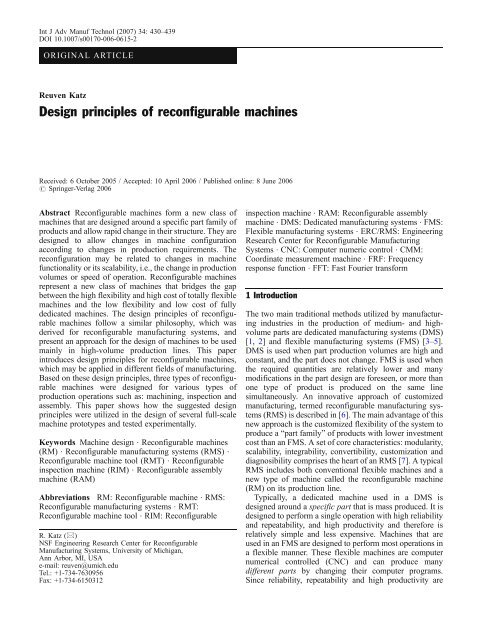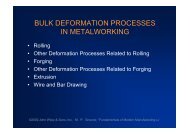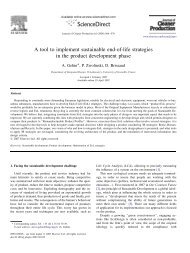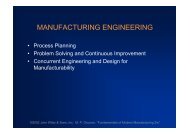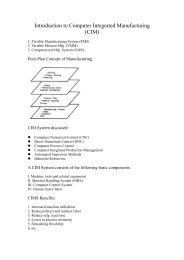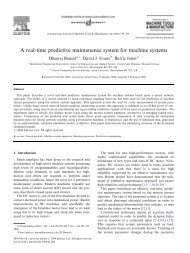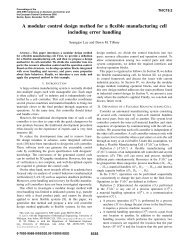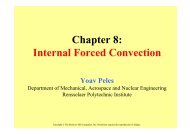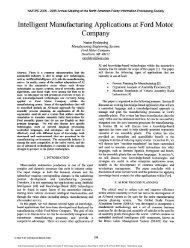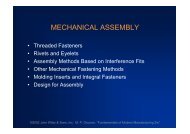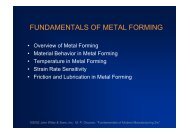Design principles of reconfigurable machines
Design principles of reconfigurable machines
Design principles of reconfigurable machines
You also want an ePaper? Increase the reach of your titles
YUMPU automatically turns print PDFs into web optimized ePapers that Google loves.
Int J Adv Manuf Technol (2007) 34: 430–439DOI 10.1007/s00170-006-0615-2ORIGINAL ARTICLEReuven Katz<strong>Design</strong> <strong>principles</strong> <strong>of</strong> <strong>reconfigurable</strong> <strong>machines</strong>Received: 6 October 2005 / Accepted: 10 April 2006 / Published online: 8 June 2006# Springer-Verlag 2006Abstract Reconfigurable <strong>machines</strong> form a new class <strong>of</strong><strong>machines</strong> that are designed around a specific part family <strong>of</strong>products and allow rapid change in their structure. They aredesigned to allow changes in machine configurationaccording to changes in production requirements. Thereconfiguration may be related to changes in machinefunctionality or its scalability, i.e., the change in productionvolumes or speed <strong>of</strong> operation. Reconfigurable <strong>machines</strong>represent a new class <strong>of</strong> <strong>machines</strong> that bridges the gapbetween the high flexibility and high cost <strong>of</strong> totally flexible<strong>machines</strong> and the low flexibility and low cost <strong>of</strong> fullydedicated <strong>machines</strong>. The design <strong>principles</strong> <strong>of</strong> <strong>reconfigurable</strong><strong>machines</strong> follow a similar philosophy, which wasderived for <strong>reconfigurable</strong> manufacturing systems, andpresent an approach for the design <strong>of</strong> <strong>machines</strong> to be usedmainly in high-volume production lines. This paperintroduces design <strong>principles</strong> for <strong>reconfigurable</strong> <strong>machines</strong>,which may be applied in different fields <strong>of</strong> manufacturing.Based on these design <strong>principles</strong>, three types <strong>of</strong> <strong>reconfigurable</strong><strong>machines</strong> were designed for various types <strong>of</strong>production operations such as: machining, inspection andassembly. This paper shows how the suggested design<strong>principles</strong> were utilized in the design <strong>of</strong> several full-scalemachine prototypes and tested experimentally.Keywords Machine design . Reconfigurable <strong>machines</strong>(RM) . Reconfigurable manufacturing systems (RMS) .Reconfigurable machine tool (RMT) . Reconfigurableinspection machine (RIM) . Reconfigurable assemblymachine (RAM)Abbreviations RM: Reconfigurable machine . RMS:Reconfigurable manufacturing systems . RMT:Reconfigurable machine tool . RIM: ReconfigurableR. Katz (*)NSF Engineering Research Center for ReconfigurableManufacturing Systems, University <strong>of</strong> Michigan,Ann Arbor, MI, USAe-mail: reuven@umich.eduTel.: +1-734-7630956Fax: +1-734-6150312inspection machine . RAM: Reconfigurable assemblymachine . DMS: Dedicated manufacturing systems . FMS:Flexible manufacturing systems . ERC/RMS: EngineeringResearch Center for Reconfigurable ManufacturingSystems . CNC: Computer numeric control . CMM:Coordinate measurement machine . FRF: Frequencyresponse function . FFT: Fast Fourier transform1 IntroductionThe two main traditional methods utilized by manufacturingindustries in the production <strong>of</strong> medium- and highvolumeparts are dedicated manufacturing systems (DMS)[1, 2] and flexible manufacturing systems (FMS) [3–5].DMS is used when part production volumes are high andconstant, and the part does not change. FMS is used whenthe required quantities are relatively lower and manymodifications in the part design are foreseen, or more thanone type <strong>of</strong> product is produced on the same linesimultaneously. An innovative approach <strong>of</strong> customizedmanufacturing, termed <strong>reconfigurable</strong> manufacturing systems(RMS) is described in [6]. The main advantage <strong>of</strong> thisnew approach is the customized flexibility <strong>of</strong> the system toproduce a “part family” <strong>of</strong> products with lower investmentcost than an FMS. A set <strong>of</strong> core characteristics: modularity,scalability, integrability, convertibility, customization anddiagnosibility comprises the heart <strong>of</strong> an RMS [7]. A typicalRMS includes both conventional flexible <strong>machines</strong> and anew type <strong>of</strong> machine called the <strong>reconfigurable</strong> machine(RM) on its production line.Typically, a dedicated machine used in a DMS isdesigned around a specific part that is mass produced. It isdesigned to perform a single operation with high reliabilityand repeatability, and high productivity and therefore isrelatively simple and less expensive. Machines that areused in an FMS are designed to perform most operations ina flexible manner. These flexible <strong>machines</strong> are computernumerical controlled (CNC) and can produce manydifferent parts by changing their computer programs.Since reliability, repeatability and high productivity are
431required for mass production lines, flexible <strong>machines</strong>designed for high volume production are relativelyexpensive. In contrast, the RM is designed for customizedflexibility, i.e., the flexibility needed to produce a particularpart family [7]. The RM can perform a pre-designed set <strong>of</strong>required operations as specified for the specific part familywith high reliability, repeatability and high productivity.The limited, customized flexibility allows reduction <strong>of</strong>investment costs on the one hand and fast response when aproduct changes on the other, both representing economicalbenefits.The innovative idea <strong>of</strong> RMS and its six core characteristicswas originally developed for “systems”, namely,mass production lines. Development <strong>of</strong> new design<strong>principles</strong> based on RMS philosophy was required inorder to design RMs. These <strong>machines</strong> are to be used onRMS lines, thereby extending the RMS concept from asystem level to the machine level.In the literature, several general <strong>principles</strong> <strong>of</strong> machinedesign have been proposed and discussed. For example,Doubbel describes <strong>principles</strong> <strong>of</strong> embodiment design suchas: principle <strong>of</strong> division <strong>of</strong> tasks, force and energytransmission, as well as safety and reliability <strong>principles</strong>[8]. Norton defines engineering design as “The process <strong>of</strong>applying the various techniques and scientific <strong>principles</strong>for the purpose <strong>of</strong> defining a device, a process or a systemin sufficient detail to permit its realization” and alsodescribes the phases <strong>of</strong> the design process [9]. Suh presentsa thorough discussion <strong>of</strong> the design process in engineeringusing mathematical tools and shows examples <strong>of</strong> machinedesign [10]. He presents the design equation that relates thefunctional requirements vector {FR} to the design parameters{DP} vector using the design matrix [A]. Using thisapproach, he studies different cases <strong>of</strong> coupled design,redundant design and ideal design. Other researchers focuson design <strong>principles</strong> <strong>of</strong> <strong>machines</strong> which are used primarilyfor manufacturing. Altintas presents fundamental <strong>principles</strong><strong>of</strong> designing CNC machine tools [11]. It includessizing and selecting drive motors, configuration <strong>of</strong> physicalstructure and modeling <strong>of</strong> servo control. <strong>Design</strong> <strong>principles</strong><strong>of</strong> CNC machine tools were also presented in detail byKoren [12]. <strong>Design</strong> <strong>principles</strong> <strong>of</strong> machining systems aswell as an upgradeable multi spindle RM are discussed in[13]. RM design concepts are studied in [14] with the goal<strong>of</strong> developing “modular <strong>reconfigurable</strong> machine”. Asstated there, the key characteristics <strong>of</strong> modular machinedesign were focused on decomposition, standardizationand exchangeability. According to [15], the design <strong>of</strong> RMSis based on a construction kit principle that enables it toadjust to new production requirements by substitution,addition or removal <strong>of</strong> machine systems. A synthesismethodology for designing <strong>reconfigurable</strong> machine tools(RMT) [16, 17] takes a set <strong>of</strong> functional requirements and aset <strong>of</strong> process plans as the input and generates a set <strong>of</strong>kinematically viable RMTs to meet the given specifications.A thorough study <strong>of</strong> machine tools scalability in thecontext <strong>of</strong> RMS is presented and discussed in [18]. Currentstudies are focused on improving dynamic design capabilities<strong>of</strong> RMTs [19] and on a modular approach forRMT servo axis modeling [20]. The derived machine toolmodels can be used for design and control <strong>of</strong> RMT servoaxes. When high volumes <strong>of</strong> parts are produced, there is aneed for rapid and low cost inspection equipment formeasuring geometrical and dimensional tolerances as wellas surface quality. Typically, dedicated gages that aredesigned for high precision and high repeatability areexpensive and are not flexible to product changes [21].Therefore, manufacturers prefer using flexible coordinatemeasuring <strong>machines</strong> (CMM) that can measure manydifferent parts or features [22]. An interesting application<strong>of</strong> the general design <strong>principles</strong> proposed by Suh [10]demonstrates a methodology for selecting a measuringsystem for inspection <strong>of</strong> mechanical parts [23]. Utilizingthis methodology, the authors selected a flexible CMMbasedsystem for completing their task.The goal <strong>of</strong> this paper is to introduce and explain thedesign <strong>principles</strong> <strong>of</strong> RMs. These design <strong>principles</strong> followthe concepts and vision <strong>of</strong> the RMS philosophy presentedin [6, 7] and introduce a complete set <strong>of</strong> practical design<strong>principles</strong>. Based on these design <strong>principles</strong>, several RMswere designed. The paper presents three examples <strong>of</strong> such<strong>machines</strong> designed for machining, inspection and assemblyoperations. We explain how the design <strong>principles</strong> arereflected in the actual design <strong>of</strong> each machine. Metalcutting, metrology and assembly represent differentmanufacturing operations; however, similar design <strong>principles</strong>have been used to design RMs for each <strong>of</strong> theseoperations. Two full-scale prototypes <strong>of</strong> RMs were built(Sections 3 and 4). These RMs were experimentally testedto evaluate their reconfigurability features as well as theirfunctional performance. The paper briefly describes some<strong>of</strong> these studies and refers the readers to more completedocumentation <strong>of</strong> our research efforts.Section 2 presents and explains the design <strong>principles</strong> <strong>of</strong>RMs. Sections 3, 4 and 5 describe each RM that wasdesigned based on the design <strong>principles</strong> discussed inSection 2. First a brief description <strong>of</strong> the machine isprovided. Then, the application <strong>of</strong> the design <strong>principles</strong>during the design phase as well as the studies andvalidation performed for each machine is discussed.Section 6 summarizes the paper and presents concludingremarks.2 <strong>Design</strong> <strong>principles</strong>An RM is a machine that is specifically designed to handleproduct variants within a specific part family. A gooddesign <strong>of</strong> an RM is a design that makes it pr<strong>of</strong>icient inhandling changes and simplifies the changeover procedure.The design <strong>principles</strong> <strong>of</strong> RMs follow the philosophy <strong>of</strong><strong>reconfigurable</strong> manufacturing systems. RMs are designedmainly for mass production applications. RMs are designedto allow customized flexibility and a cost-effectiveproduction and inspection <strong>of</strong> a family <strong>of</strong> parts.A machine is classified as an RM if its design follows thenecessary principle and several <strong>of</strong> the primary <strong>principles</strong>stated below.
432Necessary principle:1. A <strong>reconfigurable</strong> machine is designed around aspecific part family <strong>of</strong> products.Primary <strong>principles</strong>:2. A <strong>reconfigurable</strong> machine is designed for customizedflexibility only.3. A <strong>reconfigurable</strong> machine is designed for easy andrapid convertibility.4. A <strong>reconfigurable</strong> machine is designed for scalability:allows addition or removal <strong>of</strong> elements that increaseproductivity or efficiency <strong>of</strong> operation.5. A <strong>reconfigurable</strong> machine is designed to allowreconfiguration <strong>of</strong> the machine to operate at severallocations along the production line performing differenttasks at different locations, using the same basicstructure.6. A <strong>reconfigurable</strong> machine should be designed applyingmodularity concepts, namely, using common “buildingblocks” and common interfaces.Clarifying remarks:1. The first principle is necessary in defining a machine asa RM. The other five <strong>principles</strong> are the key <strong>principles</strong>that specify the essence <strong>of</strong> RMs.2. Part family, in principle 1, is a set <strong>of</strong> parts with similarcharacteristics. A characteristic is a distinguishableproperty <strong>of</strong> a part e.g. material, geometry, shape orcolor. Similarity can be difficult to measure dependingon the property. Two parts can be similar based on oneset <strong>of</strong> properties, but different when a second set isconsidered. When machined parts are considered, thechoice <strong>of</strong> geometric and shape properties is common.Cylinder heads for different engines may be regarded apart family. Similarly, several types <strong>of</strong> engine blockscan form a part family. However, a cylinder head andan engine block <strong>of</strong> the same engine may not belong tothe same part family. Rigorous definitions anddiscussion <strong>of</strong> part families can be found in [24]. Thedefinition <strong>of</strong> a part family in our context is broad toallow each manufacturing business to define its ownpart family and design a RM according to its specificneeds.3. Customized flexibility, mentioned in principle 2,means that a machine possesses only a limited amount<strong>of</strong> flexibility related to several specific features asrequired from the design specifications. General flexibilitymeans that a single flexible machine can dealwith a large variety <strong>of</strong> features such as in a computernumerically controlled (CNC) machine tool or in ageneral-purpose coordinate measurement machine(CMM).4. The third principle <strong>of</strong> “easy and rapid convertibility”suggests that the configuration should be designed toallow easy and fast change <strong>of</strong> machine elements, rapidaddition or removal <strong>of</strong> elements and quick set up time.The designer should design means for rapid reconfiguration<strong>of</strong> the machine in advance. He or she shoulddecide how to allow fast access to fasteners andconnectors, how to design several optional locationsfor different machine elements and how to automatethe process in order to speed it up and keep it precise.5. Principle 5 refers to the requirement that the basicstructural design <strong>of</strong> a RM will allow changeableconfigurations in order to place the machine at differentlocations along the production line. At each locationthe RM will be configured to perform specific tasksthat are required for that location. In other words thesame basic RM may include different structural(hardware) elements such as spindles, sensors orgrippers as well as different s<strong>of</strong>tware configurations.6. <strong>Design</strong> for modularity is a broad principle related to thegood practice <strong>of</strong> machine design in general. In ourcontext, modularity should allow efficient reconfigurability<strong>of</strong> the machine. Standard electrical, mechanical,control and s<strong>of</strong>tware interfaces should allow rapidintegration <strong>of</strong> common elements or “building blocks”which were designed or selected in advance.3 Reconfigurable machine tool (RMT)The researchers at the ERC/RMS suggested an innovativeconcept <strong>of</strong> a machine tool [25] and developed and studiedseveral RMT concepts. Two <strong>of</strong> them have been built,demonstrated and are currently used for research [26, 27].In this paper we will focus on one machine only, the “archtype RMT” [27].3.1 Brief description <strong>of</strong> the arch type RMTThe arch type RMT, shown in Fig. 1a, was built around apart family <strong>of</strong> products with inclined surfaces, which existin some automotive engine blocks or cylinder heads. It wasdesigned for a mass production line for both milling anddrilling on inclined surfaces.The machine tool has three controlled degrees <strong>of</strong>freedom along its column, along the spindle axis andalong the table axis. One additional passive motion is theangular reconfiguration motion <strong>of</strong> the spindle, whichallows reconfiguring the spindle’s angular position int<strong>of</strong>ive pre-designed locations to allow machining on differentinclined surfaces. Therefore, the arch type RMT is a nonorthogonalmachine that may have different characteristicsat each configuration <strong>of</strong> the machine.The machine is designed to drill and mill on an inclinedsurface in such a way that the tool is perpendicular to thesurface.3.2 Application <strong>of</strong> RM design <strong>principles</strong> in arch typeRMTPrinciple 1 The arch type RMT was built for a part familywith inclined surfaces found in V6 and V8 automotivecylinder heads shown in Fig. 2. During manufacturing <strong>of</strong>
433Fig. 2 RMT part family – two automotive cylinder heads: V-8 (left)and V-6 (right) [26]positioning blocks that are attached to the arch plate andbolted to have better structural rigidity and precision.Principle 5 At one location along the production line, thearch type RMT is capable <strong>of</strong> milling on an inclined surfaceand at another location, it is capable <strong>of</strong> drilling or tapping.3.3 Study and validation <strong>of</strong> arch type RMT designFig. 1 Arch type RMTthese parts there is a need for drilling, tapping or millingon inclined surfaces. Currently, typical dedicated productionlines are designed for mass production <strong>of</strong> one specificpart. The <strong>machines</strong> that operate on dedicated lines arededicated as well, i.e. are built at one specific angle andperform a single set <strong>of</strong> operations such as milling ordrilling. The introduction <strong>of</strong> the Arch Type RMT willallow changing a dedicated production line to a <strong>reconfigurable</strong>line that will allow production <strong>of</strong> a family <strong>of</strong> partswith different inclination angles without replacing<strong>machines</strong>.Principle 2 The arch type RMT was built for customizedflexibility only. The inclination angle might be changedbetween −15 degrees up to 45 degrees in steps <strong>of</strong> 15degrees as shown in Fig. 1b.Principle 3 The arch type RMT was designed for rapid andeasy convertibility by moving the spindle from one angleto another by means <strong>of</strong> a motorized mechanism and byfixing it at a precise location. When the motor brings thespindle to its required location the spindle is rested onOur key concern at the design phase <strong>of</strong> the RMT was thedynamic stability <strong>of</strong> the machine tool and how theperformance will be affected by moving a large mass <strong>of</strong>the spindle from horizontal location to 45 degrees location.Once the machine was built, dynamic characteristics <strong>of</strong> theRMT were experimentally validated using hammer testsand cutting tests [18]. It was shown after analysis <strong>of</strong> theseexperimental results that the dominant frequency in themachine’s tool frequency response function (FRF) camefrom the tool holder assembly, at above 600 Hz., regardless<strong>of</strong> spindle angular position. Figure 3a shows analyticallyderived stability lobes for cutting at 0 and 45 degrees. Point“a” represents stable cutting conditions and point “b”unstable conditions. We have performed cutting experimentsusing the parameters indicated by points “a” and “b”.Figure 3b shows the fast Fourier transform (FFT) <strong>of</strong> cuttingforce in feed direction during stable machining inhorizontal position. Figure 3c shows the FFT <strong>of</strong> cuttingforce in feed direction during unstable machining also in ahorizontal position. During unstable cutting, we get a clearsignal around 650Hz which corresponds to the tool holdermode. Similar cutting experiments were repeated at 45degrees inclination and the results showed similarcharacteristics. The results interestingly showed that thereconfiguration <strong>of</strong> machine structure does not affect archtype RMT stability.The arch type RMT was designed as a non-orthogonalmachine tool, except when in horizontal position. At thedesign phase, a thorough study <strong>of</strong> the control problemassociated with this design concept was performed [28]. Anew type <strong>of</strong> cross-coupling controller was suggested. Thestability <strong>of</strong> the control system was investigated, and
4344 Reconfigurable inspection machine (RIM)4.1 Brief descriptionThe <strong>reconfigurable</strong> inspection machine (RIM) was designedfor rapid, in-process, inspection <strong>of</strong> the machinedfeatures <strong>of</strong> a part family <strong>of</strong> cylinder heads.The RIM has been originally developed for measuringgeometric features such as: flatness, parallelism and pr<strong>of</strong>ileassociated with the cover and joint faces <strong>of</strong> an enginecylinder head [29–31].Under a different configuration, by adding a machinevision system to the structure, the RIM also allowsinspection <strong>of</strong> cylinder head surfaces for pores and othersurface texture imperfections.The RIM uses non-contact measurement methods basedon commercial laser sensors and high-definition line-scancameras in conjunction with computer vision technologyand other commercially available non-contact sensors. Aprototype <strong>of</strong> the RIM is shown in Fig. 4a.The inspected part moves along a linear axis and passesthe sensors on a servo-driven single-axis motion stage thatis equipped with a high-precision linear scale <strong>of</strong> 1 μmaccuracy. The velocity <strong>of</strong> the motion stage, as well as theprobe sampling frequency, can be varied in accordance toFig. 3 RMT dynamic characteristicssimulation was used to compare different types <strong>of</strong>controllers.The arch type RMT was designed for rapid and easyconvertibility. The process <strong>of</strong> moving the spindle from −15degrees angle to 45 degrees by means <strong>of</strong> a motorized linearstage and fixing it at a precise location was tested. It takesless than 5 min to complete the reconfiguration process inthe laboratory.The arch type RMT is capable <strong>of</strong> drilling on a surfacewith 45 degrees inclination at one location along theproduction line and another similar arch type RMT justdifferently configured is capable <strong>of</strong> milling on a surfacewith −15 degrees inclination in a different location.In the design phase there was a plan to introducemodularity features to the Arch Type RMT by usingstandard interfaces in order to enable easy spindlesexchangeability. We have not succeeded in this effortsince it required close cooperation with spindles supplier.An outstanding example <strong>of</strong> modular design <strong>of</strong> spindleinterfaces for machine tools is presented in [15], where thespindle has standard interfaces for: power, media, data,alignment and tool change that allowed the development <strong>of</strong>the “multi coupling” concept that utilizes modularity<strong>principles</strong>.Fig. 4 Reconfigurable inspection machine
435the required sampling density and inspection cycle time.The linear position along the axis <strong>of</strong> travel is recorded foreach measurement point, which enables a precise mapping<strong>of</strong> the part surface without being affected by variations inthe motion stage velocity.The RIM is intended for use in an industrial environment.It is located adjacent to the machining line with atotal cycle time including part transfer equal to that <strong>of</strong> themachining line, which is assumed to be around 40 seconds.Radio Frequency (RF) technology was demonstrated in thelaboratory for reading the RF tag located on the part fixtureto identify the specific part number to be evaluated. Uponcompletion <strong>of</strong> the measurements and feature evaluations,the results <strong>of</strong> the evaluation were stored on the RF tag andon the RIM database. A bock diagram <strong>of</strong> the RIM systemarchitecture is presented in Fig. 5.Fig. 6 RIM part family <strong>of</strong> engine cylinder headsmeasuring distance between two features centers atanother location along the line as presented schematicallyin Fig. 7.4.2 Application <strong>of</strong> RM design <strong>principles</strong> in RIMPrinciple 1 The RIM was built around a part family <strong>of</strong>engine cylinder heads that during mass-production needin-line inspection. Typical parts that belong to this partfamily are shown in Fig. 6. These engine cylinder headswere produced by different companies for different types<strong>of</strong> engines. However, all <strong>of</strong> them have common characteristicfeatures such as precisely machined flat surfaces,prismatic shape and a series <strong>of</strong> threaded holes.Principle 2 The RIM was built for customized flexibilityonly. The machine is capable <strong>of</strong> measuring variousfeatures <strong>of</strong> cylinder heads <strong>of</strong> various sizes; however, it isnot designed to measure all features <strong>of</strong> one part or tomeasure other parts that are not from the same part family.Principle 3 The RIM is designed for rapid and easyconvertibility by adding sensors when needed and bychanging the location <strong>of</strong> existing sensors as required forinspection <strong>of</strong> different parts or different features <strong>of</strong> thesame part.Principle 4 The RIM was designed to be scalable, i.e., toallow mounting <strong>of</strong> different probes at different locationsprepared at the outset. The scalability enables efficientmeasurements <strong>of</strong> different features.Principle 5 The RIM is capable <strong>of</strong> measuring surfaceflatness at one location along the production line andFig. 5 RIM system architecture4.3 Study and validation <strong>of</strong> RIM designIn this section, we demonstrate the RM design <strong>principles</strong>and their implementation as reflected in RIM design. Also,RIM performance as a non-contact inspection machine wasexperimentally validated.The <strong>reconfigurable</strong> inspection machine was designedaround a part family <strong>of</strong> engine cylinder heads as explainedearlier. To measure each <strong>of</strong> the heads, different fixtureswere designed and used. For each head, the location <strong>of</strong> thelaser sensors as well as the position <strong>of</strong> the vision systemwere reconfigured to capture all features <strong>of</strong> interest.The RIM can measure geometrical and dimensionalfeatures such as: flatness <strong>of</strong> a surface and parallelismbetween two surfaces, distance between surfaces distancebetween edges and related dimensional features. The RIMis not designed, however, to measure the roundness <strong>of</strong>parts, since roundness is not relevant for inspectingcylinder heads, which are prismatic parts. We have testedexperimentally the quality <strong>of</strong> RIM measurements. Table 1presents RIM repeatability experimental results tested innominal condition when measuring a reference part. Themeasurements show good nominal repeatability <strong>of</strong> theRIM.Currently, the coordinate measurement machine(CMM), is the standard tool for industrial inspection <strong>of</strong>machined parts. It uses a touch-probe with a 0.5 to 2.0-mmdiameter ball. Utilizing the ConoProbe sensor on RIM, itslaser beam has a typical diameter <strong>of</strong> 20μm. Therefore, onecan expect different readings when using these two types <strong>of</strong>sensors on machined surface with a non-perfect surfacefinish. In order to compare RIM measurement results withthe results <strong>of</strong> a coordinate measurement machine (CMM),the “virtual ball” method was developed and implemented[32]. It provides the interpretations <strong>of</strong> non-contact lasermeasurements as if they have been performed by a CMMtouch-probe. A comparison between measurements fromthe RIM and a CMM, and repeatability results from theRIM are presented in [33].Figure 4b shows a typical design-for-convertibility <strong>of</strong>the RIM structure and fixtures. The design included a series
436Fig. 7 RIM integration onproduction line<strong>of</strong> threaded holes to allow fast and easy relocation <strong>of</strong>various sensors and accessories needed for inspection.While measuring different features on different types <strong>of</strong>cylinder heads, we have changed the fixtures and thelocation <strong>of</strong> the sensors many times. A typical time periodrequired for relocation <strong>of</strong> sensors when different heads aremeasured is less than an hour. The calibration process <strong>of</strong>the sensors following reconfiguration process <strong>of</strong> the RIM[34] was successfully tested in the laboratory.To demonstrate scalability <strong>of</strong> the system, the RIM wastested with a differing number <strong>of</strong> sensors. We started withtwo laser sensors for surface flatness inspection and weincreased the number <strong>of</strong> laser sensors to four whenmeasuring parallelism [35]. We also applied machinevision systems based on a line scanning camera and usedboth the 4 K and 8 K pixels versions. We could use eachtype <strong>of</strong> sensor separately or together in parallel during thescan <strong>of</strong> the cylinder head surface. One important application<strong>of</strong> the vision system was measuring surface defectssuch as casting originated pores on machined surfaces [36].A typical image <strong>of</strong> pores on cylinder head surface is shownin Fig. 8. Figure 8a shows a pore which is connected to anedge <strong>of</strong> a machined feature while Fig. 8b presents an“isolated pore”. For each pore <strong>of</strong> interest we can analyze itssize and the location relative to some given datum. Basedon our porosity inspection research, one <strong>of</strong> ERC/RMSindustrial partners is currently building a full-scale machineto be located and used on a production line <strong>of</strong> cylinderheads replacing visual inspection.5 Reconfigurable assembly machine5.1 Brief descriptionThe <strong>reconfigurable</strong> assembly machine (RAM) described inthis paper is an assembly machine for automotive heatexchangers (radiators) [37]. Dr. M. Mehrabi and hisgraduate students have conducted a study and conceptuallydesigned the RAM together with an ERC/RMS industrialpartner.Heat exchangers are rectangular matrices comprisingtubes and fins bordered by headers and side supports asshown in Fig. 9. The assembly process starts by feedingtubes and fins to the core-builder area. The tubes are in theform <strong>of</strong> stacks that are fed into the core-builder whereas thefins are supplied in trays that contain the required number<strong>of</strong> fins per radiator. The machine then places one tubefollowed by one fin from the respective sources and theprocess iterates till the required quantity <strong>of</strong> fins and tubes isreached. The collection <strong>of</strong> tubes and fins that are looselyheld together is termed as a ‘loose matrix’. This loosematrix is then transferred to the final assembly area where itis capped with side supports and headers after beingcompressed to the correct dimensions and checked foralignment. The tubes are to be pressed into the slotsprovided in the headers and therefore their alignment isfairly important. The finished product received from thefinal assembly area is termed as the ‘core’. Before the corecan be removed from the assembly area, it is constrained byTable 1 Repeatability measurements performed on a reference partInspection number Width Parallelism Joint face flatness Cover face flatness1 118,975.1 9.3 9.5 9.32 118,975.1 8.7 8.7 8.83 118,975.2 8.8 8.7 8.74 118,975.1 8.5 8.4 8.55 118,975.1 10.1 9.3 9.5Mean value 118,975.1 9.1 8.9 9.0Repeatability (range) 0.1 1.5 1.1 1.0Values are in μm. (Repeatability is defined as the difference between the max and min values in the range defined by the five inspectionsperformed)
437Fig. 10 The core-builder [37]5.2 Application <strong>of</strong> RM design <strong>principles</strong> in RAMPrinciple 1 The RAM was designed around a part family<strong>of</strong> heat exchangers with different dimensions and differentnumbers <strong>of</strong> fins and tubes. It is an assembly machine usedby automotive radiators manufacturers. Many differenttypes <strong>of</strong> radiators, which could be assembled by RAM,were identified and classified into three main groups thatdefine the “part family” [37]. This topic will be furtherexplained in the next section.Fig. 8 Porosity on machined surfacethe use <strong>of</strong> brass frames. A new pick and place mechanismwas designed to perform the task <strong>of</strong> placing the headers andside supports into the assembly fixtures. The design <strong>of</strong> thenew <strong>reconfigurable</strong> pick and place mechanism led todrastic reduction in final assembly time. The conceptualdesign <strong>of</strong> the core-builder is presented in Fig. 10.The similarities between various products are based ongeometrical features. A greater width results in a greaternumber <strong>of</strong> tubes and fins. An existing assembly machinecan assemble heat exchangers in 45 to 60 s. The designgoal <strong>of</strong> the RAM was to reduce assembly time to 30 s andallow assembly <strong>of</strong> various types <strong>of</strong> heat exchangers thatbelong to the same part family utilizing <strong>reconfigurable</strong>design <strong>principles</strong>.Principle 2 The machine was designed for customizedflexibility as it can perform only some <strong>of</strong> the assemblytasks related to core-building <strong>of</strong> these heat exchangers thatbelong to the defined part family.Principle 3 The RAM was designed for rapid convertibilityto allow the assembly <strong>of</strong> different sizes <strong>of</strong> heatexchangers. Replacing the automated core builder elementssuch as the pick and place mechanism and the loosematrix grippers, allows assembly <strong>of</strong> different types andsizes <strong>of</strong> products.Principle 6 The RAM was designed to use differentmodules or building blocks that are integrated into theassembly machine to allow the assembly <strong>of</strong> different parts.Modular elements <strong>of</strong> pick and place devices and gripperswere designed for different sizes <strong>of</strong> heat exchangers.5.3 Study and validation <strong>of</strong> RAM designThe RAM team has studied the characteristics <strong>of</strong> a typicalcore-builder that our industrial partner has designed andTable 2 RAM-part family [25]Subgroups Length Width Total productsFig. 9 Heat exchanger [37]1 20 20 272 20 20–32 1003 20–30 1/2 20 219rejected 45
438built for its customers. The team investigated this corebuilder’sfunctionality and tried to understand its limitationsand improve them.The study led to the conclusion that the productivity <strong>of</strong>the existing core-builder is constrained by elevatedchangeover and cycle times. Therefore, the goal was tominimize changeover time and hence reduce the idle state<strong>of</strong> the system. The constraint to productivity formed by thechangeover time can be addressed effectively by makingthe machine <strong>reconfigurable</strong>. As previously stated, RMs arespecifically designed to handle changes within a partfamily. Their modular design significantly contributestowards the reduction in changeover time. The changeoversin RAM are reduced to the interchanging <strong>of</strong> modulesinstead <strong>of</strong> the many adjustments needed in the existingassembly <strong>machines</strong>, when assembling different products.The first step in the design <strong>of</strong> a RM is a clearidentification <strong>of</strong> the part family. Using our industrialpartner’s products catalog, 398 radiators were classifiedand grouped. Combinations <strong>of</strong> product features werestudied in order to establish a relationship between theproduct characteristics. The information for this studyconsisted <strong>of</strong> product features such as model, length, width,height, number <strong>of</strong> rows and car that uses it. Theserelationships were utilized to define part families dependingon the characteristics that are more imperative tomachine architecture. The study <strong>of</strong> these relationshipsconcluded that the length and the width are the mostimportant parameters that affect the reconfigurability <strong>of</strong> themachine to the greatest extent.As a result <strong>of</strong> this study [38], three main subgroupsdefine the RAM part family, and a few rejected productswere identified as listed in Table 2. With the newlystructured part family, the number <strong>of</strong> required modules hasreduced to three; each <strong>of</strong> them takes care <strong>of</strong> one sub group,whereas still more than 90% <strong>of</strong> the product range wascovered. If the design <strong>of</strong> the modules is based on this partfamily definition then the resulting machine will handlechanges within product sub group without requiringchangeover at all, and if the change is across a part familythen the changeover will be restricted to a change <strong>of</strong> amodule. Hence, extended changeover time that leads tolarge downtimes, can be avoided. The easy changes acrossthe part family represent a good example <strong>of</strong> design forconvertibility. The design <strong>principles</strong> and the study <strong>of</strong> RAMwere not validated experimentally since the machine wasnot built.6 Summary and conclusionsThis paper outlines the importance <strong>of</strong> design <strong>principles</strong> forRMs. Based on the design <strong>principles</strong> presented in thispaper, the ideas presented in the RMT and RIM patents [25,29] were realized. Each <strong>of</strong> the full-scale RMs wasexperimentally tested for the validation <strong>of</strong> reconfiguration<strong>principles</strong> as well as for sound functional performance. Theprototypes described in the paper currently serve asresearch platforms.The main contributions <strong>of</strong> this paper are as follows:– The RMS vision was refined into concrete machinedesign <strong>principles</strong> for the design <strong>of</strong> RMs that can beused in a manufacturing system.– The generality <strong>of</strong> application <strong>of</strong> these <strong>principles</strong> wasdemonstrated in various manufacturing domains suchas machining, assembly and metrology.– The importance <strong>of</strong> the aforementioned design <strong>principles</strong>was validated for RMs.– Studies that demonstrate reconfigurability and goodperformance <strong>of</strong> the RMs that used the design <strong>principles</strong>for RMs were presented.The conclusions <strong>of</strong> our study are as follows:– RMs represent a new class <strong>of</strong> <strong>machines</strong> that aredesigned mainly for high-volume production applications.They bridge the gap between the flexible<strong>machines</strong> and the dedicated <strong>machines</strong>.– Not all design <strong>principles</strong> presented in this paper mustbe reflected in the design <strong>of</strong> each specific RM.However, the principle <strong>of</strong> a machine that is designedaround a part family is a necessary condition andshould be reflected in the design.– The design <strong>principles</strong> were demonstrated in the design<strong>of</strong> <strong>reconfigurable</strong> machining, inspection and assembly<strong>machines</strong>; however, this philosophy is general and maybe applied to other domains <strong>of</strong> machine design.– The design <strong>principles</strong> <strong>of</strong> RMs and RMS follow asimilar philosophy.– RMs enable production <strong>of</strong> different products thatbelong to the same part family by allowing rapidand efficient pre-designed changes <strong>of</strong> a machine’sconfiguration.– The design <strong>principles</strong> <strong>of</strong> RMs are focused mainly onthe functionality <strong>of</strong> these <strong>machines</strong> and are importantin the phase <strong>of</strong> conceptual design. The detailed design<strong>of</strong> a RM follows concepts similar to any other machinedesign.– The suggested design <strong>principles</strong> do not contradict anytraditional design <strong>principles</strong> related to the goodpractice <strong>of</strong> machine design.Acknowledgements The author would like to thank Pr<strong>of</strong>. Y. Korenfor his RMS vision and his remarks to this paper and to the teams <strong>of</strong>researchers and graduate students who participated in the RMT, RIMand RAM projects. The author would like to thank V. Srivatsan, J.Duphia and Dr. P. Spicer for their feedback and remarks to this paper.The author also gratefully acknowledges the financial support <strong>of</strong> theNSF Engineering Research Center for Reconfigurable MachiningSystems (NSF Grant EEC95-92125) at the University <strong>of</strong> Michigan.References1. Mehrabi MG, Ulsoy AG, Koren Y (2000) Reconfigurablemanufacturing systems: key to future manufacturing. J IntellManuf 11(4):403–4192. Altiok T (1996) Analysis <strong>of</strong> manufacturing systems. Springer,Berlin Heidelberg New York
4393. Kaighobadi M, Venkatesh K (1993) Flexible manufacturingsystems: an overview. Int J Oper Manage 14(4):26–494. Mehrabi MG, Ulsoy AG, Koren Y, Heytler P, (2002) Trendsand perspectives in flexible and <strong>reconfigurable</strong> manufacturingsystems. J Intell Manuf 13(2):135–1465. Sethi AK, Sethi SP (1990) Flexibility in manufacturing: asurvey. Int J Flex Manuf Syst 2:289–3286. Koren Y, Jovane F, Heisel U, Pritschow G, Ulsoy G,VanBrussel H (1999) Reconfigurable manufacturing systems.Keynote paper. CIRP Annals 2:6–127. Koren Y, Ulsoy AG (2002) Vision, <strong>principles</strong> and impact <strong>of</strong><strong>reconfigurable</strong> manufacturing systems. Powertrain International,pp 14–218. Doubbel H (1994) Handbook <strong>of</strong> mechanical engineering.Springer, Berlin Heidelberg New York9. Norton RL (2000) Machine design an integrated approach.Prentice-Hall, New York10. Suh NP (1990) The <strong>principles</strong> <strong>of</strong> design. Oxford UniversityPress, Oxford11. Altintas Y (2000) Manufacturing automation: metal cuttingmechanics, machine tool vibrations, and CNC design. CambridgeUniversity Press, Cambridge12. Koren Y (1983) Computer control <strong>of</strong> manufacturing systems.McGraw-Hill, New York13. Spicer P, Koren Y, Shpitalni M, Yip-Hoi D (2002) <strong>Design</strong><strong>principles</strong> for machining system configurations. CIRP AnnManuf Technol 51:275–28014. Bright G, Xing B, Craig S (2005) Modular machine design for<strong>reconfigurable</strong> manufacturing. 3rd CIRP Conference on RMS,Ann Arbor, MI15. Abele E, Worn A, Stroh C, Elzenheimer J (2005) Multimachining technology integration in RMS, 3rd CIRP Intl.Conference on RMS ‘05, Ann Arbor, MI16. Moon YM, Kota S (2002) <strong>Design</strong> <strong>of</strong> <strong>reconfigurable</strong> machinetools. ASME J Manuf Sci Eng 124:480–48317. Moon YM, Kota S (2002) Generalized kinematic modeling <strong>of</strong><strong>reconfigurable</strong> machine tools. ASME J Mech Des 124:47–5118. Spicer P, Yip-Hoi D, Koren Y (2005) Scalable <strong>reconfigurable</strong>equipment design <strong>principles</strong>. Int J Prod Res 43(22):4839–485219. Dhupia J, Powalka B, Katz R, Ulsoy AG (2005) Effect <strong>of</strong>reconfiguration degrees <strong>of</strong> freedom on dynamics <strong>of</strong> a machinetool. 3rd CIRP Intl. Conference on RMS ‘05, Ann Arbor, MI20. Ersal T, Stein JL, Louca LS (2004) A modular modelingapproach for the design <strong>of</strong> <strong>reconfigurable</strong> machine tools. ProcASME IMECE ’04, Anaheim, CA21. Farago F, Curtis MA (1994) Handbook <strong>of</strong> dimensionalmeasurement. Industrial Press Inc.22. Bosch JA (ed) (1995) Coordinate measuring <strong>machines</strong> andsystems. Marcel Dekker, New York23. Coelho AG, Mourao AF, Navas HG (2004) A rational way toselect a measuring system for mechanical parts inspection. Proc<strong>of</strong> ICAD ’04, Seoul, Korea24. Ramesh M, Yip-Hoi D, Dutta D (2001) Feature-based shapesimilarity measurement for retrieval <strong>of</strong> mechanical parts. JComput Inf Sci Eng 1:245–25625. Koren Y, Kota S (1999) Reconfigurable machine tool. USPatent # 5,943,75026. Landers RG, Min BK, Koren Y (2001) Reconfigurable machinetools. Ann CIRP 50:269–27427. Katz R, Chung H (1999) <strong>Design</strong> <strong>of</strong> an experimental arch type<strong>reconfigurable</strong> machine tool. Proc 2000 JUSFA, 2000 Japan-USA Symposium on Flexible Automation, July 23–26, 2000,Ann Arbor, MI28. Katz R, Yook J, Koren Y (2004) Control <strong>of</strong> <strong>reconfigurable</strong>machine tool. ASME J Dyn Syst Meas Control 126:397–40529. Koren Y, Katz R (2003) Reconfigurable apparatus and methodfor Inspection during a Manufacturing Process. USPatent # 6,567,16230. Katz R, Zuteck MG, Koren Y (2002) Rapid inspection anderror-tracing methodology for machining production lines.CIRP ICME ‘02, Ischia (Naples), Italy31. Katz R, Zuteck MG, Koren Y (2002) Reconfigurable inspectionmachine for machining production lines. Proc Global PowerTrain Conference 2002, Ann Arbor, MI32. Barhak J, Katz R (2003) Interpretation <strong>of</strong> laser measurementsproduced by the <strong>reconfigurable</strong> inspection machine using the“virtual ball” method. Proc CIRP- 2nd Intl. Conference onRMS ‘03, Ann Arbor, MI33. Barhak J, Katz R (2004) Rapid non-contact measurements <strong>of</strong>engine cylinder heads with the <strong>reconfigurable</strong> inspectionmachine. CIRP ICME ‘04, Sorrento, Italy34. Gupta A, Segall S, Katz R (2004) Motion stage errorcompensation technique with verification methodology for a<strong>reconfigurable</strong> inspection machine. ASME Proc 2004 Japan-USA Symposium on Flexible Automation35. Barhak J, Djurdjanovic D, Spicer P, Katz R (2005) Integration<strong>of</strong> <strong>reconfigurable</strong> inspection with stream <strong>of</strong> variations methodology.Int J Mach Tools Manuf 45(4–5):407–41936. Kalyanaraman A, Katz R, Lock T, Spicer P, Warlick Z, (2004)Cylinder head surface porosity inspection. University <strong>of</strong>Michigan, ERC/RMS TR-051-0437. Bair N, Kidwai T, Koren Y, Mehrabi M, Wayne S, Prater L(2002) <strong>Design</strong> <strong>of</strong> a <strong>reconfigurable</strong> assembly system formanufacturing heat exchangers. Japan-USA Symposium onFlexible Manufacturing, July14–19, Hiroshima38. Kidwai T (2002) <strong>Design</strong> <strong>of</strong> a <strong>reconfigurable</strong> core-builder: anassembly machine for heat exchangers. University <strong>of</strong> Michigan,ERC/RMS-TR-056-05


